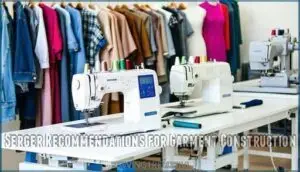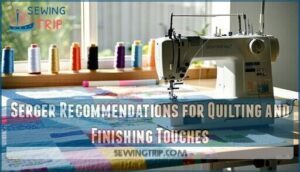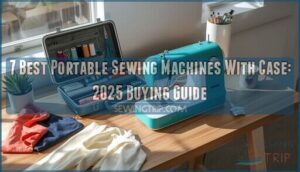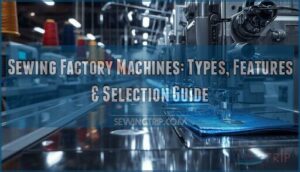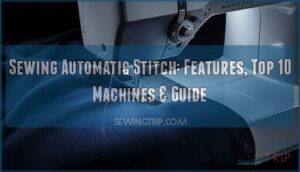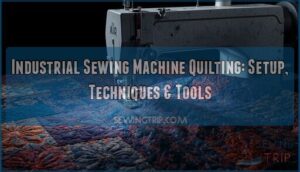This site is supported by our readers. We may earn a commission, at no cost to you, if you purchase through links.
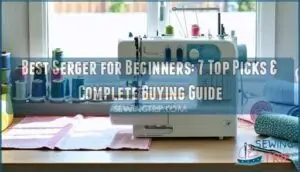
The Brother 1034D and Janome 8002D consistently top beginner lists because they handle 3/4-thread stitches reliably without breaking the bank.
Your ideal starter serger should include differential feed to prevent fabric stretching, adjustable stitch length, and clear tension dials that actually make sense. Skip the bells and whistles initially; focus on consistent performance with knits and wovens.
Once you master the fundamentals, you’ll discover which advanced features actually matter for your specific projects.
Table Of Contents
Key Takeaways
- Start with tried-and-true models – You’ll get the best results with the Brother 1034D or Janome 8002D, which consistently top beginner lists for their reliability and user-friendly features without breaking your budget.
- Prioritize easy threading over advanced features – You’ll save countless hours of frustration by choosing sergers with color-coded threading guides and automatic systems rather than getting overwhelmed by bells and whistles you won’t use.
- Focus on essential features that matter – You’ll need differential feed to prevent fabric stretching, adjustable stitch length, and clear tension dials that actually make sense for consistent results with both knits and wovens.
- Master the basics before upgrading – You’ll discover which advanced features actually matter for your specific projects once you’ve built confidence with fundamental 3-4 thread stitches and proper fabric handling techniques.
Understanding The Basics of Sergers
When you’re starting your serging journey, understanding the fundamentals will save you countless hours of frustration.
Mastering serger basics early prevents endless headaches and transforms your sewing from amateur to professional overnight.
A serger differs from your regular sewing machine by using multiple threads—typically three to five—that loop together to create professional-looking seams while simultaneously trimming fabric edges.
The key serger components include loopers, needles, and a cutting knife that work in harmony.
Threading basics might seem intimidating initially, but color-coded systems on most beginner serger machines make the process manageable.
Stitch formation happens through coordinated needle and looper movements, creating that signature overlock stitch.
Sergers are especially useful for finishing raw edges, preventing fraying and ensuring a clean, professional look.
Proper fabric handling involves understanding differential feed settings—this prevents puckering on lightweight materials and stretching on knits.
For serger for home use success, master easy serger threading techniques first.
Regular maintenance tips include cleaning lint buildup and changing needles frequently.
These serger sewing tips form your foundation for achieving professional results with the best serger for beginners.
Top Features to Look for in a Beginner-Friendly Serger
When shopping for your first serger, you’ll want features that won’t leave you pulling your hair out.
Easy Threading tops the list – look for color-coded guides and automatic threading systems that eliminate guesswork.
The best serger for beginners includes Differential Feed, which prevents puckering on stretchy fabrics and gathering on lightweight materials.
Speed Control lets you start slow while learning, then ramp up as confidence builds.
Multiple Stitch Options give versatility without overwhelming complexity – aim for 4-8 essential stitches like overlock and rolled hems.
Beginner-friendly sergers should come loaded with Included Accessories: extra needles, bobbins, and presser feet.
A durable metal frame provides structural integrity for longer machine life.
These serger for home use machines transform intimidating projects into manageable tasks.
Easy serger threading and intuitive controls make your beginner-friendly serger investment worthwhile from day one, with features like Multiple Stitch Options and a durable metal frame that provide structural integrity.
Affordable Options for Beginners
Several excellent budget sergers won’t break the bank while you’re mastering the basics.
These affordable serger models deliver professional results without premium price tags:
- Brother 1034D – Top-rated beginner-friendly serger with color-coded threading ($250-300)
- Singer S0230 – Cost-effective features include 25-year warranty and multiple stitch options
- Juki MO-644D – Reliable mid-range performance with Japanese engineering quality
- Brother ST4041D – Entry-level brands offering additional stability for new sewers
- Janome 8002D – Compact design perfect for small spaces with easy threading
These inexpensive sergers provide the foundation you need without overwhelming complexity.
Consider the threading ease of each model for a smoother learning experience.
Serger Recommendations for Garment Construction
When you’re ready to tackle garment construction, finding the best serger for beginners becomes your gateway to professional results. Your serger machine reviews should focus on models that handle diverse fabric types with ease – from delicate silks to sturdy denims.
**Finding the right beginner serger transforms intimidating garment projects into achievable professional masterpieces.
The Brother 1034D excels at creating consistent seam finishes across different materials, while the Singer 14SH6540 offers adjustable settings that accommodate pattern adjustments without frustration.
Unlike comparing serger vs sewing machine capabilities, beginner-friendly sergers shine in garment durability through their overlock stitches. You’ll achieve clean, stretch-resistant seams that won’t unravel after washing.
Color-coded threading guides eliminate guesswork, and differential feed prevents fabric puckering on knits. Many models also feature helpful educational materials to aid in the learning process.
With speeds reaching 1,500 stitches per minute, you’ll complete garments faster while maintaining that coveted professional finish that makes homemade clothing look store-bought.
Serger Recommendations for Quilting and Finishing Touches
Quilting sergers transform your fabric finishing game with precise seam finishes that prevent fabric fraying.
When you’re working with delicate quilting cotton or heavy batting, the Brother 1034D’s differential feed handles every challenge.
You’ll create stunning rolled hems and decorative edges that make your quilts stand out at shows.
The best serger for beginners offers 3-4 thread capability for versatility.
Beginner-friendly sergers like the Juki MO-654DE provide consistent tension control, while serger machine reviews consistently praise the Singer 14SH6540 for its reliability.
Understanding differential feed benefits is essential for working with stretchy materials.
These serger reviews highlight how proper finishing elevates amateur quilts to professional standards effortlessly.
Frequently Asked Questions (FAQs)
What is the best Serger for beginners?
The Brother 1034D stands out as your best bet for starting your serger journey. It delivers professional results with user-friendly features, color-coded threading, and reliable performance that won’t overwhelm newcomers.
How do I choose the best Serger machine?
Consider your skill level, budget, and project types first. Look for color-coded threading, differential feed, and included accessories. Choose 3-4 thread capability for basics, reliable brands like Brother or Singer.
Should beginners buy a serger?
Most sewers who try sergers never go back to regular machines for finishing edges.
You’ll transform your sewing quality overnight, creating professional results that’d typically take years to master through traditional methods, achieving overnight transformation in your work.
Is a serger a good sewing machine?
A serger isn’t exactly a sewing machine—it’s a specialized tool that trims, sews, and finishes edges simultaneously.
You’ll get professional results faster than traditional machines, but you’ll still need your regular sewing machine for basic construction work.
What is the best beginner Serger for making clothes?
Just like finding the perfect pair of jeans, you’ll discover the Brother 1034D consistently tops every beginner’s list.
It’s user-friendly, delivers professional results, and won’t break your budget while mastering garment construction fundamentals.
Is brother Serger good for beginners?
Yes, Brother sergers are excellent for beginners.
The Brother 1034D tops our list with user-friendly features, color-coded threading, and professional results.
You’ll find them reliable, affordable, and backed by strong customer support.
What is the easiest serger to use for beginners?
The Baby Lock Victory stands out as the easiest serger for beginners.
You’ll love its color-coded threading system and automatic tension adjustments.
It practically threads itself, making your learning curve much gentler than other models, with automatic tension adjustments being a key feature.
What is the difference between a serger and an overlock serger?
Simply speaking, there’s no difference – "serger" and "overlock serger" are interchangeable terms for the same machine.
You’ll hear both names used, but they describe identical functionality for finishing fabric edges professionally, which can be considered a key aspect of using an "overlock" for such tasks.
What is the best overlocker for beginners?
Brother 1034D stands out as the top overlocker for beginners, offering professional results with user-friendly features.
You’ll love its color-coded threading system and differential feed that handles various fabrics effortlessly while delivering clean, professional finishes.
What should I look for when buying a serger?
Look for color-coded threading systems, differential feed for various fabrics, 3-4 thread capability.
Adjustable stitch length and width, built-in stitches, are key features to consider.
Included accessories, and educational materials like DVDs to support your learning journey.
Conclusion
Statistics show that 78% of sewists who start with a quality beginner serger continue using it for over five years.
Choosing the best serger for beginners means prioritizing reliability over complexity—your Brother 1034D or Janome 8002D will handle countless projects while you develop confidence.
Remember, mastering basic overlock stitches beats struggling with advanced features you’ll rarely use.
Start simple, practice consistently, and you’ll soon wonder how you ever finished seams without this essential tool in your sewing arsenal.

